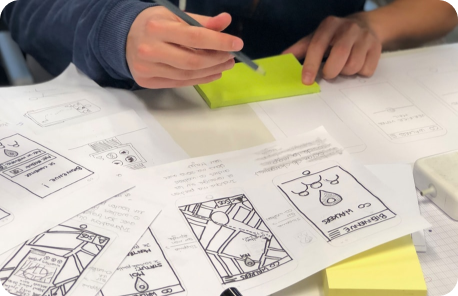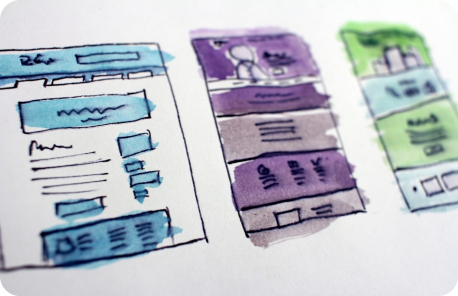User experience is fundamental to how people engage with a product, application, system or service. It goes beyond whether or not something is just ‘enjoyable’ to use — it also can have a significant impact on a product’s operability and/or usability experience.
When a product does not meet the expectations of its target audience then it poses a risk of being abandoned or avoided entirely. In many cases, the user experience of a product will be what determines the outcome of a company’s business goals and its overall success.
UX research is one of the most powerful tools a designer has for making sure that a product effectively addresses the needs of its users. That’s why in this blog post, we’ll explore what UX research is, how it fits into the product development process, and the substantial benefits it can provide to product development teams from concept to launch.

What is UX Research?
UX research is a technique used to learn about the behaviors, needs, and pain points of users as they interact with a product. Through UX research, a product designer is able to generate insights into how users expect a product to function, if it is able to solve a problem they are facing, and any feedback that they have about the experience of using it.
We often conflate the practice of UX research with user research because of their similarities but it’s important to make the distinction between the two since they serve different purposes. Instead of being focused on how users interact with a specific product, user research is more broad — aiming to understand key information about who users are and what behaviors they have. Using this information, a product designer can develop a persona which reflects the type of user their product is intended to serve.
Research can take the form of either qualitative (interviews, field studies, questionnaires, focus groups) or quantitative research (surveys, data analysis, online polls;) the results of each being useful for framing a clear problem statement from which a product design can be developed.
How Does UX Research Fit Into the Product Development Process?
UX research can be applied to help product designers better understand the needs of their users and how their design may or may not be serving them. This is why it is considered to be useful within multiple phases of the product development process.
During the discovery phase, UX research is generally focused towards:
- Learning about what barriers or problems a user faces while using products that are similar to what you intend to build
- Understanding a user’s mental models and pain points
- Developing empathy for the user
- Synthesizing research findings into actionable insights
- Creating a user persona that represents the result of the research findings
And within the design/prototyping phases, UX research can take the form of:
- Information architecture validation
- User flow tests
- Content analysis
- Usability testing
But even after the deployment phase, UX research still serves an important purpose. It’s at this point that end users will be engaging with a product and inevitably will provide feedback on the user experience. If a product is something like an application where it can be improved upon after release, this feedback becomes valuable research data that can be used to help inform where development is prioritized.

Now, let’s explore some of the benefits that UX research has on product development:
Benefit #1: Understand Your Target Audience
Without knowing who a product is being built for, designers will be challenged to create a user experience that meets the unique needs of the audience it will eventually serve. After all, a target audience is not something that is stumbled upon accidentally — it requires careful consideration and the synthesis of research data before it can be extrapolated.
Using user research, it is possible to infer what demographic a potential customer belongs to, how they behave towards a given product category, and what motivates them. These usually come in the form of secondary research (published reports, data sets, etc) because a product designer will often need access to a large pool of data before they’re able to hone in on a specific target audience.
Benefit #2: Make Product Decisions Based on Real Data
Making assumptions is one of the most risky actions that a designer can take when trying to create a product to directly satisfy or solve a problem in a user’s life. Without a connection to what users have said they need or the pain points they’ve expressed, a designer cannot be certain in the efficacy of a solution.
This is what makes UX research so valuable — it provides evidence from which a team can directly reference prior to making decisions on the user experience of their product. They can leverage data from earlier phases (e.g. interview quotes, survey statistics, secondary research) or data from later phases (e.g. usability testing, heat maps, user feedback) to gain insight into the impact a product change might have and feel more confident in applying it.
Tangible research data also makes it much easier to communicate and collaborate within a product team. Assumptions carry risk because they’re influenced by an individual’s unique biases and may lack empathy for the actual needs of an end user. This can be especially true when working within a team because now there are even more perspectives to consider. As a result, a product team may find it difficult to arrive at a solution or will make a decision which negatively impacts the user experience of a product.
Benefit #3: Identify Accessibility Barriers
More than 1 in 4 adults in the United States have some type of disability. For many users, this impairs their ability to use technology and, as a result, creates barriers that prevent them from enjoying the same access as others. Through user research, a product designer can learn about what accessibility challenges a user might face and gain empathy for the ways that it affects their life.
Depending on the nature of a product, there may be ways to provide meaningful accessibility in order to address the needs of disabled users. In fact, the earlier that accessibility is considered, the more effective it is and less difficult it becomes to implement. In the case of a website or mobile application, these might be as simple as some visual tweaks to provide easier legibility or more complex like supporting screen readers, magnification, being usable with keyboard-only, etc. Every user's experience is unique and by understanding the pain points of those with disabilities a designer can identify what accessibility barriers exist in a product and work to remedy them before release.

Benefit #4: Save Time & Money
There is a cost associated with every action a product team takes over each phase of development. Generally, the further into development a product is, the more expensive it becomes to make major changes to its design and functionality.
With user research, teams can collect evidential data during the planning phase that will help them understand how users expect a product to function. They can also learn about the pain points user experiences with similar products so that they can be considered during design and development.
While it is inevitable that a product will require updates after usability testing is conducted and customers share their feedback about the user experience, fundamental design issues that require extensive redesigns are far more critical and expensive to solve later in development. User research and usability testing do carry their own costs but they can result in significant savings later in development that far outweigh their initial investments.
Benefit #5: A Better User Experience Means a More Successful Product
User experience is at the core of what makes a successful product and companies who choose to prioritize it will see compelling benefits over the course of its lifecycle.
The more enjoyable a product is to use, the greater chance it has at motivating its customers to passionately advocate for it — whether it’s recommending it to their friends, family, co-workers, or even strangers online. These types of people are often referred to as evangelists and serve an important role in helping companies maintain a positive perception of their product amongst its target audience.

Customers also want to feel like their input and feedback is valued throughout a product's development or after it has been released. This provides a sense of ownership over the product's success and makes it so that customers are more likely to advocate for the brand in exchange.
Conclusion
Throughout this post we’ve explored what makes UX research an essential part of the product development process. It is clear that the benefits of applying UX research techniques like user research and usability testing to product development result in streamlined design processes, higher quality products, and even increased savings.
While we’ve primarily focused on user research, it is important to not ignore hands-on research methods like usability testing, paper prototyping, testing user flows, etc. These reveal critical insights about how people use products and how they expect them to function that can save a product from having to undergo extensive (and costly) design revisions.
If your product development team doesn’t have the time or resources to conduct thorough usability testing, consider utilizing PLUS QA usability testing services instead. With us, teams will benefit from access to:
- A diverse group of testers from various demographics and backgrounds
- Testing conducted on real devices, not emulators or virtual machines
- Moderated and unmoderated sessions options (including extensive in-person studies at our Portland facility.)
- Testers trained in QA fundamentals, enabling them to spot complex usability issues
- An integrated approach that connects usability with functional and accessibility testing
Contact us for more information today!
